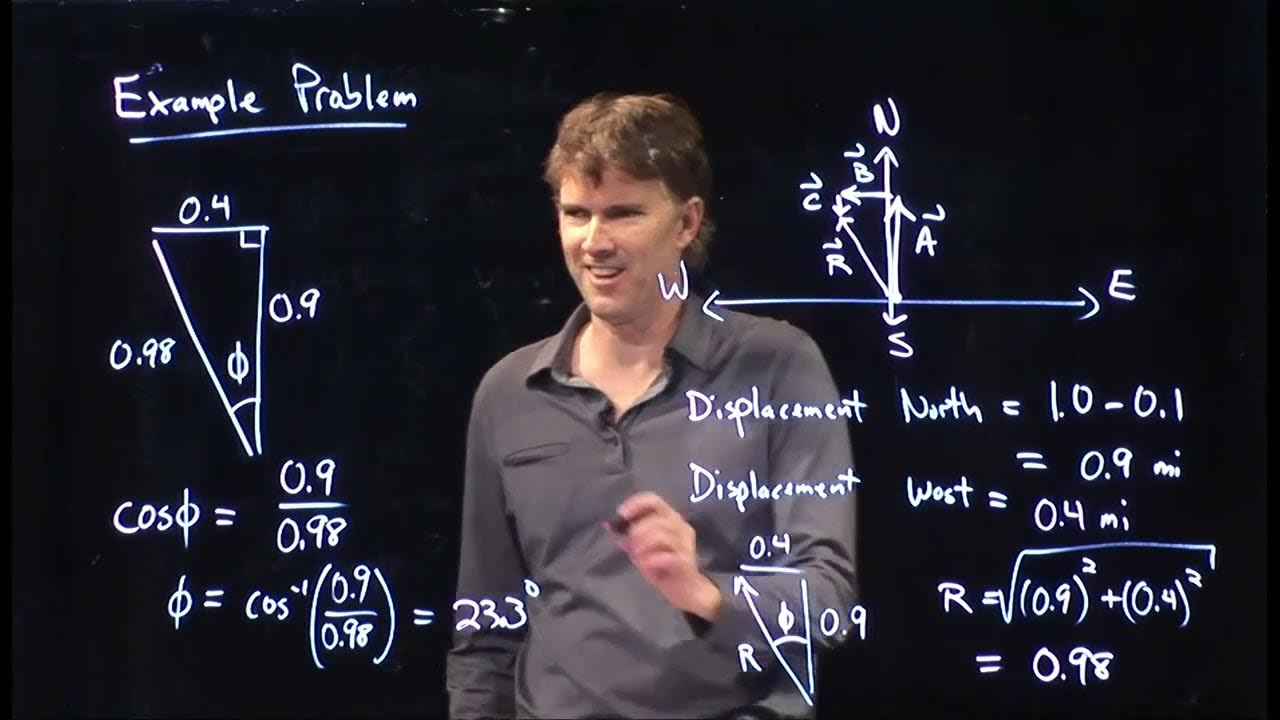Position Vectors and Displacement Vectors - Physics
TLDRThis video script introduces the concept of position vectors and their application in calculating displacement vectors. It explains how to represent a point in a 2D coordinate system and extends the explanation to a 3D coordinate system. The script also covers how to determine the magnitude of a position vector and illustrates the process of finding the displacement vector as a particle moves from one point to another. The information is presented with clear examples, making it accessible for learners interested in improving their understanding of vectors.
Takeaways
- 📌 Position vectors are used to calculate displacement vectors.
- 📍 A position vector is drawn from the origin to a point of interest on a graph.
- 🔢 The position vector for a 2D coordinate system is represented as 3i + 2j, where i and j are unit vectors along the x and y axes respectively.
- 📈 In a 3D coordinate system, the position vector includes a z component, such as 3i + 4j + 5k.
- 👓 The magnitude (length) of a position vector in 2D is found using the formula √(x^2 + y^2).
- 📊 For a 3D position vector, the magnitude is calculated as √(x^2 + y^2 + z^2).
- 🔄 The displacement vector is the change in position from one point to another and is found by subtracting the initial position vector from the final position vector.
- 🌟 Displacement is the straight-line distance between two points and not the path taken.
- 📚 The video provides an example of calculating the displacement vector as (5i - 2j + 3k) - (2i + 3j + 4k) = 3i - 5j + 4k.
- 💡 The video script also mentions a resource for an ebook and a free chapter on passing math and science classes, available on the website video.tutor.net.
Q & A
What are position vectors?
-Position vectors are vectors that represent a point's location in a coordinate system by starting from the origin and pointing towards the specific point of interest. They are denoted by the symbol 'r' with a vector symbol attached.
How is a position vector represented in a 2D coordinate system?
-In a 2D coordinate system, a position vector is represented by its x and y components. For example, for a point P at (3, 2), the position vector is represented as 3i + 2j.
How do you calculate the position vector for a point in a 3D coordinate system?
-To calculate the position vector for a point in a 3D coordinate system, you determine the differences in the x, y, and z values from the origin. For instance, a point P at (3, 4, 5) would have a position vector of 3i + 4j + 5k.
What is the magnitude of a position vector?
-The magnitude of a position vector, also known as its length, is the distance from the origin to the point in the coordinate system. For a 2D vector, it's calculated as the square root of the sum of the squares of its components (x^2 + y^2). For a 3D vector, it's the square root of the sum of the squares of all three components (x^2 + y^2 + z^2).
How do you find the displacement vector when a particle moves from one point to another?
-To find the displacement vector, you calculate the difference between the position vectors of the final and initial positions. The displacement vector represents the change in position from the initial point to the final point.
What is the displacement vector for a particle moving from point A (2, 3, 4) to point B (5, -2, 8)?
-The displacement vector is found by subtracting the position vector of point A from that of point B. In this case, it would be (5i - 2i) + (-2j - 3j) + (8k - 4k), which simplifies to 3i - 5j + 4k.
How do position vectors help in understanding movement in a coordinate system?
-Position vectors provide a clear and mathematical way to understand and calculate the movement of a particle or object within a coordinate system. They allow us to determine not only the direction but also the distance traveled, which is crucial in various applications of physics and engineering.
What is the significance of the origin in the context of position vectors?
-The origin is the reference point in a coordinate system from which all position vectors begin. It is of vital importance because it establishes a frame of reference and allows us to quantify positions relative to this central point.
How do you visually represent a position vector on a graph?
-A position vector is visually represented by drawing a directed line (or arrow) from the origin to the specific point in the coordinate system that it corresponds to. The direction of the line indicates the direction of the vector, and its endpoint indicates the location of the point.
What is the relationship between the components of a position vector and the coordinate system?
-The components of a position vector directly correspond to the differences in the coordinates of the point from the origin in each dimension of the coordinate system. For example, in a 2D system, the x-component represents the horizontal distance and the y-component the vertical distance from the origin.
How can you use the magnitude of a position vector to determine the distance between two points?
-The magnitude of a position vector gives you the straight-line distance from the origin to the point it represents. To find the distance between two points, you can calculate the magnitude of the difference between their position vectors, which gives you the displacement or distance between those two points.
Outlines
📐 Introduction to Position Vectors and Displacement Calculation
This paragraph introduces the concept of position vectors and their use in calculating displacement vectors. It begins by visually representing a graph with the x and y axes and places a point P at coordinates (3,2). The position vector is explained as a vector originating from the origin and pointing towards a specific point, represented by the symbol 'r' with a vector arrow. The process of finding the position vector is described by taking the difference in x and y values from the origin. The example given shows how to calculate the position vector for point P as 3i + 2j. The concept is then extended to a 3D coordinate system with a point P at (3,4,5), and the position vector is calculated as 3i + 4j + 5k. The paragraph concludes with a method to determine the length of the position vector, which is the magnitude of the vector, calculated using the square root of the sum of the squares of its components.
🚀 Displacement Vector Calculation using Position Vectors
This paragraph delves into the calculation of displacement vectors as a particle moves from one point to another. It provides a step-by-step explanation of how to find the position vectors for two points, A (2,3,4) and B (5,-2,8), in a 3D coordinate system. The position vectors for points A and B are calculated as 2i + 3j + 4k and 5i - 2j + 8k, respectively. The displacement vector is then found by taking the difference between the position vectors of points B and A. The calculation involves subtracting the components of the initial position vector (from A) from the final position vector (from B), resulting in a displacement vector of 3i - 5j + 4k. The paragraph also mentions a website, video.tutor.net, where viewers can access resources for passing math and science classes, and offers a free first chapter by joining an email list.
Mindmap
Keywords
💡Position Vectors
💡Displacement Vector
💡Graph
💡Origin
💡X-axis
💡Y-axis
💡Z-axis
💡Magnitude
💡Components
💡Cartesian Coordinate System
💡Motion
Highlights
Introduction to position vectors and their application in calculating displacement vectors.
Definition of position vectors as vectors that start from the origin and point to a particular point of interest.
Explanation of how to represent position vectors using the symbol r with a vector symbol attached.
Procedure for finding the position vector of a point in a 2D coordinate system by using the differences in X and Y values.
Example of calculating the position vector for point P (3, 2) in a 2D coordinate system, resulting in the vector 3i + 2j.
Explanation of how to determine the length of a position vector, which is the magnitude of the vector.
Formula for calculating the magnitude of a position vector in a 2D coordinate system (square root of x squared + y squared).
Formula for calculating the magnitude of a position vector in a 3D coordinate system (square root of x squared + y squared + z squared).
Example of calculating the position vector for point P (3, 4, 5) in a 3D coordinate system, resulting in the vector 3i + 4j + 5k.
Process of finding the displacement vector as the difference between the position vectors of two points.
Example of calculating the displacement vector as the particle moves from point A (2, 3, 4) to point B (5, -2, 8).
Illustration of the displacement vector calculation by subtracting the initial position vector from the final position vector.
Result of the displacement vector calculation: 3i - 5j + 4k.
Discussion on the practical application of position and displacement vectors in understanding particle motion.
Invitation to visit the website video.tutor.net for resources on passing math and science classes.
Offer to join the email list for a free chapter of the ebook on academic success.
Transcripts
Browse More Related Video

Unit Vectors | Physics with Professor Matt Anderson | M3-06

Displacement Vectors and Adding Multiple Vectors | Physics with Professor Matt Anderson | M3-04

Adding Vectors Example | Physics with Professor Matt Anderson | M3-10

Tensor Calculus 3a: The Covariant Basis

Lec 1: Dot product | MIT 18.02 Multivariable Calculus, Fall 2007

How to find the component form of a vector
5.0 / 5 (0 votes)
Thanks for rating: